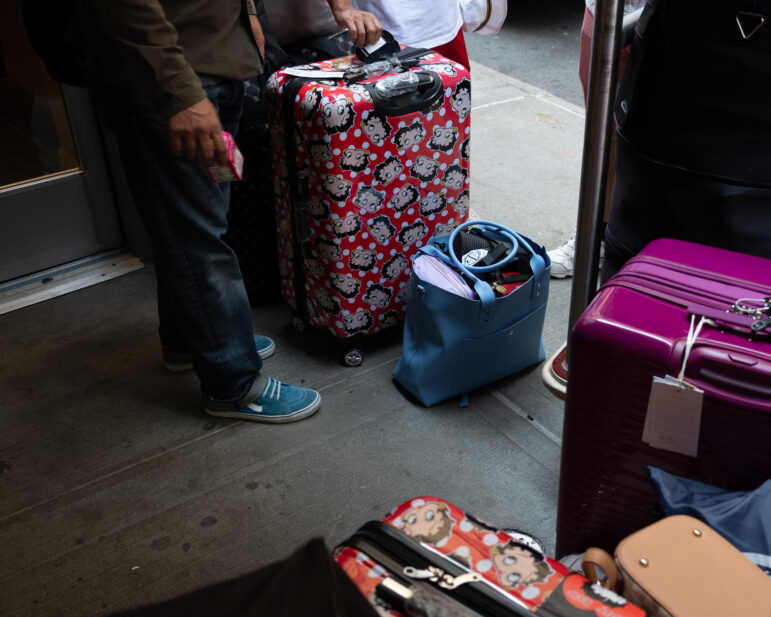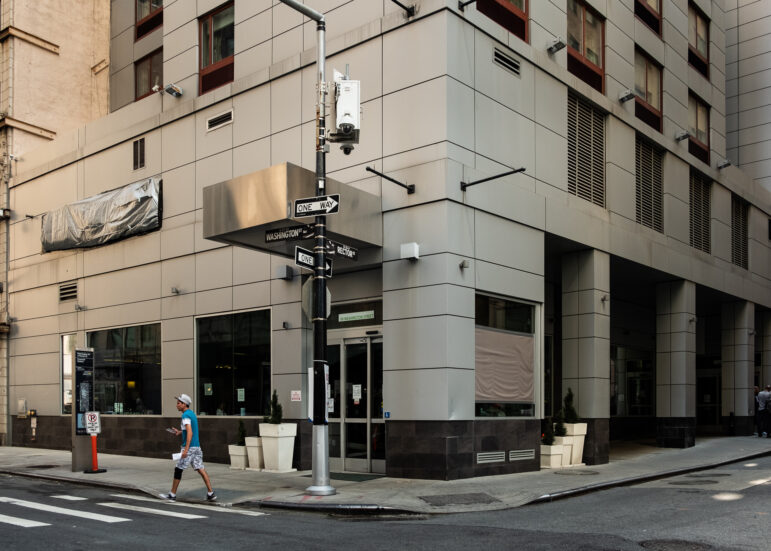City Limits spoke with several of the immigrants being transferred from the Holiday Inn Manhattan downtown to the new, large congregate shelter on Randall’s Island, a group that included a pregnant woman and asylum seekers on crutches, among others.

Adi Talwar
Immigrant adults staying at an emergency shelter hotel at 99 Washington St. began moving out last week, as the city seeks to create space for families with children.Lea la versión en español aquí
Move-out letters were quietly slipped under the doors of asylum seekers’ rooms at the Humanitarian Emergency Response and Relief Center (HERRC) at 99 Washington St. the last weekend of August.
“I woke up to go to the bathroom at 4 a.m., and I saw the letter on the entrance floor,” said Carlos, who asked that his full name not be used for fear of retaliation, in Spanish.
A number of immigrants staying at the HERRC, based at a Holiday Inn Manhattan downtown, would be transferred out beginning Sept. 5 and ending Sept. 16, when the hotel will become a shelter for families with children, one of the letters explained.
Buses would shuttle residents from the financial district hotel to the recently opened migrant tent shelter on Randall’s Island, one of the city’s largest such facilities, with a capacity for up to 2,000 people. “All current 99 Washington guests will be welcomed at the new HERRCs site at Randall’s Island,” reads the move-out letter obtained by City Limits, which was printed in both English and Spanish.
Last week, a few days after the notification letters were issued, City Limits spoke with several who received them, a group that included a pregnant woman, a mother of an adult child with disabilities, asylum seekers on crutches, among others. It wasn’t immediately clear how many at the site were being transferred out of the hotel: one man who uses a wheelchair, for example, said he hadn’t been asked to move.
In addition to the more immediate move to tents on Randall’s Island, many in the group had another, larger deadline looming: earlier in August, they had received notices that they will need to leave the shelter system within 60 days. Those who can’t find alternative housing by that time will have to reapply for placement, under a policy the city announced in July to address capacity issues across the system.
“I was preparing to leave in October,” said a Colombian immigrant who also asked to remain anonymous to avoid problems, “but with this change it turns all plans to rent something upside down.” She has a contract to move into an apartment at the end of September, the woman explained, and asked to remain at the Holiday Inn until then, saying commuting to her night-shift job from Randall’s Island will be more difficult. She was not allowed to stay.
The shuffling, officials say, is needed to free up hotel beds for families with children, who under the city’s right-to-shelter rules—which Mayor Eric Adams’ administration is challenging in court—are not allowed to be placed in congregate sites. The mayor said on Sunday that it will soon not be able to meet that standard.
“We’re going to have to eventually move women and children into congregant settings,” Adams said during an interview with Pix 11.
The city has insisted for months that it is running out of shelter space, as thousands of immigrants continue to arrive weekly: since last spring, more than 110,000 have come to New York City and 59,700 are still under the city’s care.
Adams, who is pressing the federal government for more funding and to speed up work authorization for newly arrived immigrants, also ordered city agencies on Saturday to reduce spending by 5 percent in three upcoming budget plans, citing the “costs of the asylum seeker humanitarian crisis at a time when revenue growth is slowing and COVID-19 stimulus funding is sunsetting.”
“While our compassion is limitless, our resources are not,” the mayor said in a statement accompanying his announcement of the planned cuts, which drew criticism from a number of advocates and lawmakers worried it will further slow the city’s efforts to move people from shelter to permanent housing.
Last Wednesday, a multiplicity of people from around the globe prepared to descend with their suitcases, bags, and belongings at the Holiday Inn Manhattan ahead of the move to the Randall’s Island tents.

Adi Talwar
The hotel at 99 Washington St. in lower Manhattan has been used as a shelter for the last several months.City Hall did not respond to queries about how many adults are being transferred from hotels to large tent shelters overall. MedRite, an urgent care company that’s running the Holiday Inn shelter, did not respond to a request for comment. The company, which had no previous history of running a shelter, is among a group of more than 40 providers the city hired in February as part of a $304,900,000 contract, according to the Comptroller.
Among those preparing for the move was a woman on crutches for a broken foot, who preferred to remain anonymous, and said she was worried about how well she would be able to get around at the new site. The site’s remoteness was a common concern from those being sent there, and has been an argument used by local officials opposing shelters proposed for other out-of-the-way locations, such as Brooklyn’s Floyd Bennett Field, a World War II Naval air station which is expected to receive approval soon from the Biden administration for use as a shelter.
When the opening of Randall’s Island was announced, officials said the HERRC would have access to the M35 bus and a shuttle bus that will transport people to Astoria, Queens. While the M35 runs during the day as well as overnight, City Hall did not respond to questions about shuttle operating hours.
Carlos, 26, said he and his partner were previously moved to the Holiday Inn from another large group shelter because they were worried about being targeted for harassment as a gay couple. He had the same concerns about privacy and safety at the Randall’s Island site.
Coalition for the Homeless Executive Director Dave Giffen said that any pregnant woman, member of the LGBTQ community, or person with a physical or mental disability should let the shelter manager or director know about their situation, and request placement elsewhere. City Hall did not respond to questions about how it is handling such requests.
“They [shelter staff] are closed to any conversation and do not listen,” Carlos said. “There are disabled people who have no one, people with intellectual disability and have nothing stable, and they are going to be [overly] vulnerable; there are elderly people who are injured or have suffered accidents. I think they are going to be worse off than I am.”
Last Wednesday at the Holiday Inn, immigrants who’d been staying there were making a number of alternative plans: some agreed to go to the Randall’s Island shelter, some to other places in the city and to other states, while at least one person was planning to return to her country of origin.
“People are finding other opportunities,” Deputy Mayor Anne Williams-Isom said at a press briefing Wednesday. “That’s a good thing, that’s what we want to see more of—we want to see people continue to not stay in the shelter system.”
Among those preparing to initially leave the hotel last week was a woman whose 36-year-old son has cerebral paralysis. She had woken up in the early morning the previous weekend when she saw the letter on the floor notifying them of the transfer.
“My son gets headaches, anxiety,” explained the 53-year-old mother, who asked to remain anonymous. But after packing all their things for the move, she and her son had their time at the hotel extended, though it was not immediately clear how long they would get to stay.
“It saddens me to see so many people in agony for the short time they were given,” said the woman, as others left the facility.
To reach the reporter behind this story, contact Daniel@citylimits.org. To reach the editor, Jeanmarie@citylimits.org








